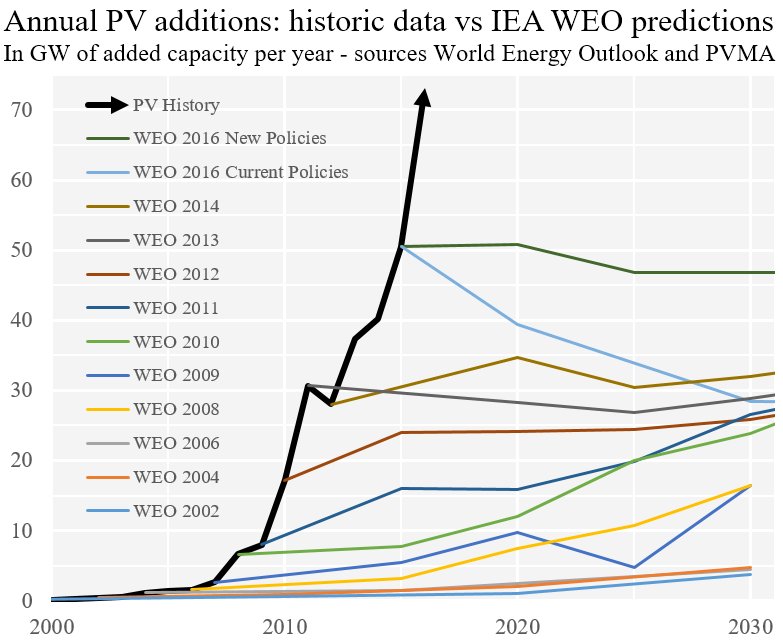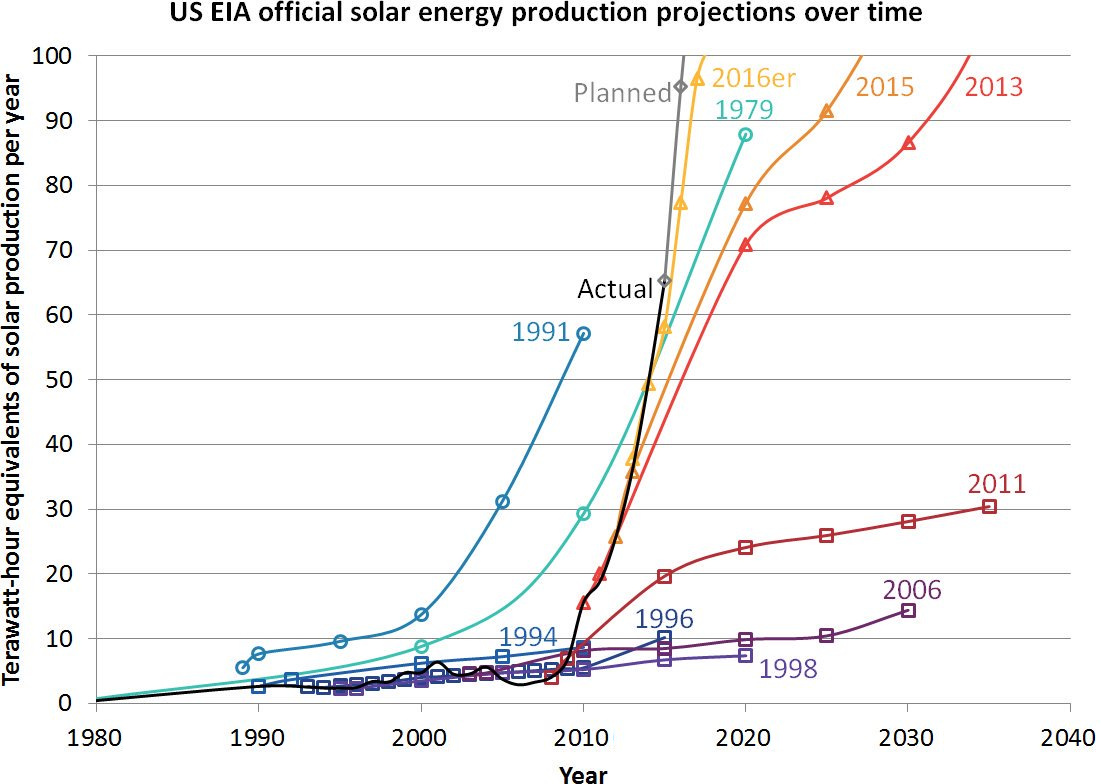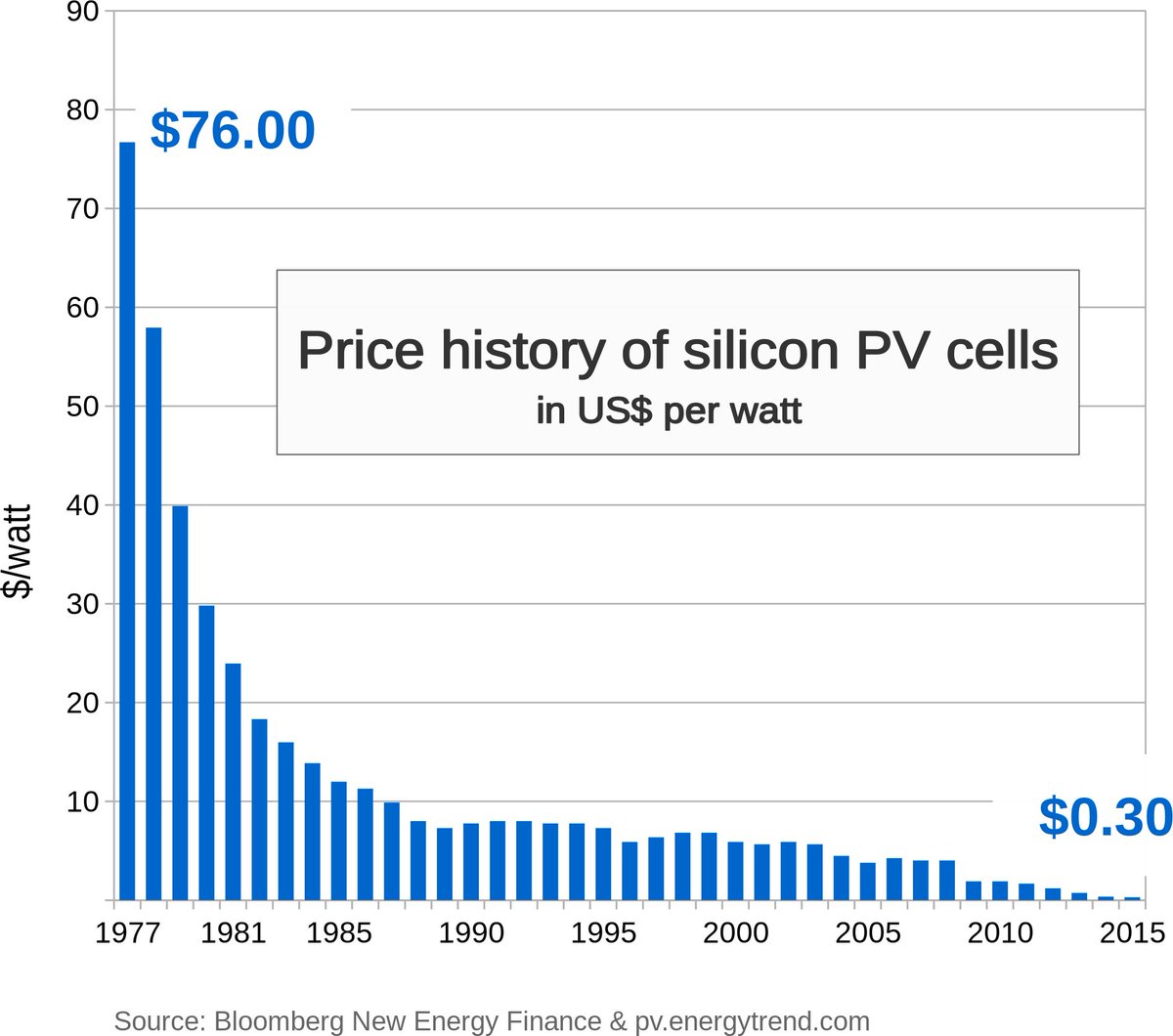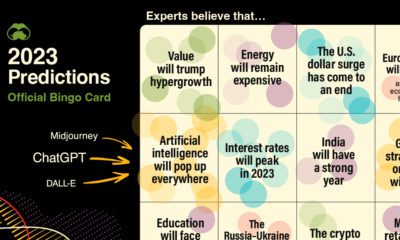However, these organizations tend to be better at some things than others. For example, in terms of summing up past and current data on what is going on in the world, they generally do a pretty good job. We referenced their numbers when we looked at the changing anatomy of U.S. oil imports, or when showing the decline in coal use over recent years. In other situations, such as trying to extrapolate numbers on current trends or predicting the tipping point of technologies, things get a bit dicier. Forecasting the roll-out of solar, in particular, has proved to be a daunting challenge for these organizations over the years.
Global Solar Installations
Before we dive in, we should make one thing clear: it’s notoriously difficult to make these types of predictions, and we do not envy the position of these researchers in any sense. That being said, as shown in this chart from Auke Hoekstra, forecasts for annual global solar installations by the IEA have been egregiously bad for over a decade.
Forecasts from the IEA are pulled from their World Energy Outlook (WEO) reports, which are published each year. Meanwhile, the “PV History” line above is the actual data for photovoltaic (PV) installations each year. Again, it’s extremely difficult to make such forecasts, and these organizations tend to be conservative with their outlooks. However, it’s pretty evident that they’ve missed a pretty significant trend here.
U.S. Solar Installations
Maybe the U.S. government can do better? Here’s a look at forecasts by the EIA for annual energy production from solar in the U.S. over many decades, courtesy of Steffen Christensen:
This one’s more interesting. Instead of counting out solar each and every year, the EIA has had changing attitudes towards solar over time. The projection from 1979 seems to actually be the most accurate – but the ones from 1994-2011 skip any premise of a solar boom entirely. As we get closer to present day, forecasts get more accurate, but are still too conservative (2013, 2015).
Hindsight is 20/20
It’s easy for us to be armchair critics, but it is not fair to rag on these organizations too much. Here’s the trend they missed that made all the difference:
Curious to see how other people have fared in making predictions on technology throughout history? Here’s a timeline of failed tech predictions that will humble any forecaster.
on
#1: High Reliability
Nuclear power plants run 24/7 and are the most reliable source of sustainable energy. Nuclear electricity generation remains steady around the clock throughout the day, week, and year. Meanwhile, daily solar generation peaks in the afternoon when electricity demand is usually lower, and wind generation depends on wind speeds.As the use of variable solar and wind power increases globally, nuclear offers a stable and reliable backbone for a clean electricity grid.
#2: Clean Electricity
Nuclear reactors use fission to generate electricity without any greenhouse gas (GHG) emissions.Consequently, nuclear power is the cleanest energy source on a lifecycle basis, measured in CO2-equivalent emissions per gigawatt-hour (GWh) of electricity produced by a power plant over its lifetime. The lifecycle emissions from a typical nuclear power plant are 273 times lower than coal and 163 times lower than natural gas. Furthermore, nuclear is relatively less resource-intensive, allowing for lower supply chain emissions than wind and solar plants.
#3: Stable Affordability
Although nuclear plants can be expensive to build, they are cost-competitive in the long run. Most nuclear plants have an initial lifetime of around 40 years, after which they can continue operating with approved lifetime extensions. Nuclear plants with lifetime extensions are the cheapest sources of electricity in the United States, and 88 of the country’s 92 reactors have received approvals for 20-year extensions. Additionally, according to the World Nuclear Association, nuclear plants are relatively less susceptible to fuel price volatility than natural gas plants, allowing for stable costs of electricity generation.
#4: Energy Efficiency
Nuclear’s high energy return on investment (EROI) exemplifies its exceptional efficiency. EROI measures how many units of energy are returned for every unit invested in building and running a power plant, over its lifetime. According to a 2018 study by Weissbach et al., nuclear’s EROI is 75 units, making it the most efficient energy source by some distance, with hydropower ranking second at 35 units.
#5: Sustainable Innovation
New, advanced reactor designs are bypassing many of the difficulties faced by traditional nuclear plants, making nuclear power more accessible.
Small Modular Reactors (SMRs) are much smaller than conventional reactors and are modular—meaning that their components can be transported and assembled in different locations. Microreactors are smaller than SMRs and are designed to provide electricity in remote and small market areas. They can also serve as backup power sources during emergencies.
These reactor designs offer several advantages, including lower initial capital costs, portability, and increased scalability.
A Nuclear-Powered Future
Nuclear power is making a remarkable comeback as countries work to achieve climate goals and ultimately, a state of energy utopia. Besides the 423 reactors in operation worldwide, another 56 reactors are under construction, and at least 69 more are planned for construction. Some nations, like Japan, have also reversed their attitudes toward nuclear power, embracing it as a clean and reliable energy source for the future. CanAlaska is a leading exploration company in the Athabasca Basin, the Earth’s richest uranium depository. Click here to learn more now. In part 3 of the Road to Energy Utopia series, we explore the unique properties of uranium, the fuel that powers nuclear reactors.
































